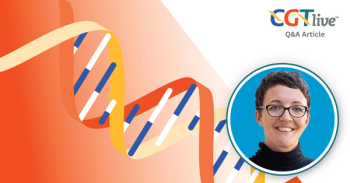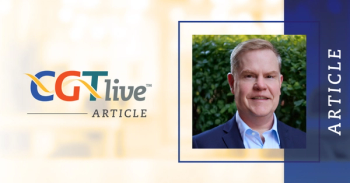
CAR T-Cell Therapy Enters a New Era in Lymphomas, But More Lessons to Learn
Brian T. Hill, MD, PhD, discusses the advent of CAR T-cell therapies, such as axicabtagene ciloleucel, tisagenlecleucel, and brexucabtagene autoleucel, and how they have shifted lymphoma treatment into a new era.
With the advent of CAR T-cell therapies, such as axicabtagene ciloleucel (axi-cel; Yescarta), tisagenlecleucel (tisa-cel; Kymriah), and brexucabtagene autoleucel (Tecartus; formerly KTE-X19), lymphoma treatment has entered a new era, according to Brian T. Hill, MD, PhD, who added that next steps will include moving these products earlier on in the treatment journey in an effort to improve outcomes.
In October 2017, the
In mantle cell lymphoma (MCL),
Another product, lisocabtagene maraleucel (liso-cel) has emerged in the treatment landscape for LBCL. In December 2019, a
“The excitement about CAR T-cell treatment is warranted because it is a single treatment,” Hill said. “Although there are significant toxicities for patients who have exhausted all other viable treatment strategies, this is something that in many patients can result in long-term remission and possibly cure. From the perspective of moving these therapies up further in earlier lines of treatment that is where the field is going.”
In an interview with OncLive® during the 2020 Institutional Perspectives in Cancer webinar on Hematologic Malignancies, Hill, director of the Lymphoid Malignancies Program and a staff physician at the Taussig Cancer Institute of Cleveland Clinic, further discussed the utility of CAR T-cell therapy in hematologic malignancies, the adverse effects (AEs) associated with this approach, and where the future of this modality is headed.
OncLive®: What is the current state of CAR T-cell therapy in hematologic malignancies?
Hill: We have entered a new era; multiple CAR T-cell treatments are now approved by the FDA or anticipated to receive approval for use in [patients with] hematologic malignancies. All the [therapies that are] currently approved target CD19. These [products] are FDA approved for use in DLBCL, acute lymphoblastic leukemia (ALL), and more recently, in MCL.
What are some of the data supporting the use of axi-cel, tisa-cel, and liso-cel in lymphoma?
The first CAR T-cell therapy that was FDA approved for lymphoma was axi-cel. [The product] was approved based on the results from the ZUMA-1 clinical trial, which was published a couple of years ago now. This was a single-arm study comprised of about 100 patients with relapsed or refractory DLBCL, transformed aggressive lymphoma, or even some cases of primary mediastinal B-cell lymphoma.
We know from historical data that patients typically have very poor outcomes with traditional chemotherapy and even some of the newer targeted agents really don’t produce durable responses. What was remarkable in this large multicenter study was that patients with truly refractory disease were able to not only enter remission—in most of the cases, this was somewhere around 70% to 80%—but we also saw a fairly high rate of CRs, in the 40% to 50% range. That [benefit] was maintained with up to 2 years of follow-up. We believe that we are probably curing a proportion of patients who were previously uncurable or [who progressed on] all treatments, including stem cell transplant. This is what has led to a lot of excitement in the field with regard to treatments like axi-cel.
Tisa-cel is also an anti-CD19 CAR T-cell treatment that has been FDA approved for ALL, and more recently, for DLBCL. Similar to the ZUMA-1 trial, we saw a high response rate and a CR ranging from 30% to 40% that appeared to be durable, [according to] long-term follow-up [data] from the JULIET trial that were published last year.
Liso-cel is not currently FDA approved but may be in the future; it is under review for approval. The study [that utilized this agent], TRANSCEND-NHL-001, was larger than ZUMA-1 and JULIET. This was a single-arm phase 2 trial that treated patients with highly refractory, aggressive B-cell lymphoma. Again, we saw durable remission rates of about 40%, suggesting that a proportion of patients with this disease may be cured [with this approach].
Where do you see the future of liso-cel headed in this space?
There is interest in liso-cel because there may be lower rates of some of the more severe toxicities [that we often see]. With further study, we do need to compare and contrast the efficacy and the toxicity profile of all 3 agents because they do have subtle differences in the composition of the CAR receptor, as well as the manufacturing steps that are involved in the creation of these products. We are still in the early days of trying to sort out the best characteristics of each of these products and which patients would benefit the most from each one.
With regard to MCL, there is brexucabtagene autoleucel. Could you speak to that product?
[With that agent], we have an FDA approval for a CAR T-cell therapy in MCL. This [product] is similar to axi-cel but has a slightly different manufacturing step. Brexucabtagene autoleucel is used to treat patients with relapsed/refractory MCL. The study that led to the FDA approval is the ZUMA-2 trial.
Patients were only allowed on the study if they had not responded or were potentially intolerant to standard BTK inhibitors, such as ibrutinib (Imbruvica) or acalabrutinib (Calquence). We know that patients with MCL who have relapsed after or become resistant to treatment with BTK inhibitors have a very short overall survival historically and, unfortunately, have typically very aggressive disease. In the ZUMA-2 trial we saw a very high overall response rate in excess of 90%, with a large number of patients, about two-thirds, achieving a CR. With the follow-up, it appears that somewhere around 50% of patients will have durable remissions.
Do you believe that CAR T-cell therapy will be moved up into earlier lines of treatment?
The excitement about CAR T-cell therapy is warranted because it is a single treatment. Although there are significant toxicities for patients who have exhausted all other viable treatment strategies, this is something that can result in long-term remission and possibly cure for many patients. From the perspective of moving these therapies up further in earlier lines of treatment that is where the field is going. There are currently 2 randomized clinical trials that have compared the standard of care, which is chemotherapy followed by consolidation with high-dose chemotherapy and autologous stem cell transplant (ASCT). That would be considered standard for these diseases at the time of relapse.
These trials went head-to-head in a randomized phase 3 design to compare the outcomes of that standard treatment, which relies on high-dose chemotherapy versus CAR T-cell therapy. The studies are accrued. However, we don’t know the results of them yet. As such, the field is eagerly waiting to hear more from those studies, both for axi-cel and tisa-cel
Could you speak to the promise of off-the-shelf products?
Off-the-shelf CAR T-cell treatment is a very exciting and interesting concept. One of the challenges with current products is that they have to be manufactured for each patient with cell collection called leukapheresis. Individual manufacturing is a little bit cumbersome and may be hampered or compromised by the fitness of the cells that you collect. The T-cell fitness and the quality of the cells that are made may be impacted by previous chemotherapy and other factors. It is appealing to imagine that there may be ways that we can collect cells from a healthy donor and engineer them into CAR T cells.
One of the main barriers to doing that is that we know if we give donor T cells or donor immune cells to patients, there is a chance for graft-versus-host disease. We need strategies to edit out components of the T-cell receptor and possibly other signaling components in the donor cells that may mediate that.
Looking forward, possibly years in the future, we may have these as more viable options. Right now, however, [these products] are still investigational and haven’t been demonstrated conclusively as a strategy that can potentially lead to durable remissions the way autologous CAR T-cell treatment has been shown to do.
What are the management strategies in place to mitigate toxicities related to CAR T-cell therapy?
The toxicities of CAR T-cell treatment is an important point of discussion. There are 2 major classes of AEs that are unique to CAR T-cells or other [immunotherapies]; those include cytokine release syndrome (CRS) and neurological toxicities. In the case of CRS, we see a high level of activation of immune effector cells mediated by cytokines, including interleukin 6 (IL-6) and others. Those cytokines lead to an array of physiologic reactions including fever, which is almost universal with CAR T-cell treatment, and other potentially more serious AEs that can include tachycardia, hypoxia and hypotension.
It is a physiology that many times requires management in an intensive care unit. We can manage this with the administration of the anti–IL-6 monoclonal antibody tocilizumab (Actemra) in many cases. However, this does require an expert level of care in centers that are considered to be authorized treatment locations for CAR T-cell therapies and have experience managing CRS, which can occur within the first 2 to 4 days after treatment [is administered].
In terms of the neurologic toxicity, this is a later event that occurs anywhere from 5 to 8 days following the cell infusion and it typically follows CRS. The mechanism of this is still being investigated but seems to be related to the elaboration of cytokines and other activating factors that lead to the recruitment of immune effector cells. [This includes] not only CAR T-cells but other lymphocytes and macrophages in other cells that may be recruited into the central nervous system due to an increased permeability of the blood–brain barrier. This could result in an array of neurological toxicities. Sometimes it is as simple as a decreased level of consciousness but could progress to aphasia. In severe circumstances, this could lead to seizures and even cerebral edema. Deaths from neurotoxicity have been reported.
The mainstay of treatment currently continues to be glucocorticoids, [which are given] at moderate or high doses depending on the grade or severity of neurotoxicity. [This approach appears to be] effective at managing this but could also lead to other AEs. If [a patient] requires long-term steroid treatment, that could lead to their immune systems being comprised if they also received prior chemotherapy, for example. It can have other unintended downstream consequences, including opportunistic infections and other complications.
Reference
Abramson JS, Palomba ML, Gordon LI, et al. Pivotal safety and efficacy results from Transcend NHL 001, a multicenter phase 1 study of lisocabtagene maraleucel (liso-cel) in relapsed/refractory (R/R) large B cell lymphomas. Blood. 2019;134(suppl 1):241. doi:10.1182/blood-2019-127508
Newsletter
Stay at the forefront of cutting-edge science with CGT—your direct line to expert insights, breakthrough data, and real-time coverage of the latest advancements in cell and gene therapy.

























